![]()
![]()
![]()
Use LEFT and RIGHT arrow keys to navigate between flashcards;
Use UP and DOWN arrow keys to flip the card;
H to show hint;
A reads text to speech;
15 Cards in this Set
- Front
- Back
|
Pre-Classic Civilization |
Mainly Olmec
2000 BCE to 200 CE
Mother culture, developed writing and calendar, first New World civilization to develop organized religion and kings, began bloodletting rituals |
|
|
Classic Civilization |
200-900 CE
Mainly Maya
High achievers, mastered writing and calendar, advanced understanding of math/astronomy, recorded lives of kings, sacrifice began |
|
|
Post-Classic Civilization |
900-1520 CE
Mostly Aztec
Warriors, major city was Tenochtitlan, ruled millions, practiced human sacrifice
Conquered by Cortez in 1519 |
|
|
Characteristics of Meso-American Art |
subjects mostly religious/mortuary used both abstraction and realism combination of text and images used composite view power shown by rigid pose and ornamentation weakness shown by natural pose and nudity |
|
|
Step Pyramid |
first seen in Olmec culture, began as burial mounds which were built up in steps, made of stone layers with temple atop
pyramid represents strong construction method |
|
|
Composite View |
human figure is drawn from front and side simultaneously, intended to show the person completely |
|
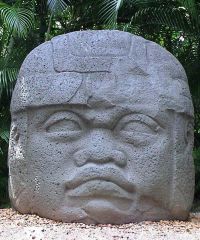
|
Olmec Colossal Head, 1200 BCE to 200 CE
abstract but realistic enough to suggest them as actual people (maybe kings), 16 total heads found, stone not native to area - probably transported via raft as wheels were used as toys |
|
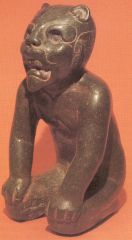
|
Olmec Jaguar Shaman, 1150-800 BCE
combines natural body with abstract jaguar, symmetrical, frontal design, were-jaguar shows common idea of animal/human motif in dieties |
|
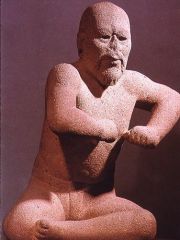
|
Olmec Wrestler Figure, 400 BCE
very naturalistic (realistic), shows artist's careful observation, pose indicates strength |
|
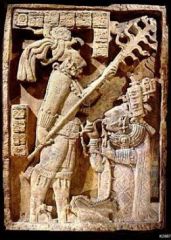
|
Maya Wall Carving (Bloodletting Rite), 725 CE
made by Cookie Cutter Master (image drawn and wall carved away), King Shield Jaguar and Lady Xol both seen in composite view, ornamentation tells of royalty |
|
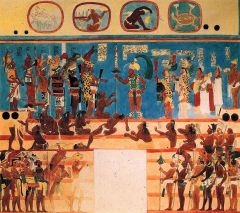
|
Maya "Ascension of New King" Mural, 800 CE
found at Bonampak (painted walls), combines text and image, uses hierarchical scale (more natural pose, less important), ornamentation shows power |
|
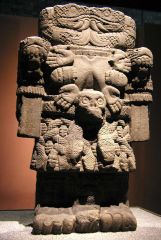
|
Aztec Coatlicue Figure, 15th century
Lady of the Skirt of Serpents, represents Earth which gives and takes life, mother of patron god Huitzilopochtli, one of last things sacrifices saw before death
snakes - flowing blood claws - digging graves, tearing flesh necklace - sacrifice |
|

|
Aztec Coyolxauhqui Disc, 15th century (coy-yol-show-kee)
moon goddess, sister of patron god Huitzilopochtli, conspired to kill mother Coatlicue, brother severed head and rolled body down a mountain, disc found at Templo Mayor where sacrifices' bodies would've fallen, done in Cookie Cutter Master style |
|
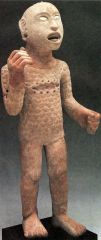
|
Aztec Xipe Totec Figure, 1450-1500 CE
wears flayed skin of victims, which peels off like ear of corn, represents death/rebirth |
|
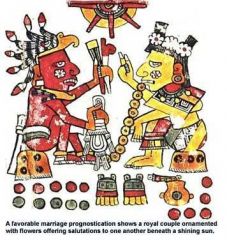
|
Aztec Codex, 1400-1500 CE
books that document their lives, most have been destroyed, show flat colors, great amounts of detail, composite views |

